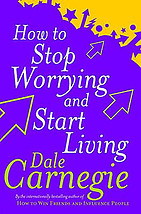Book – How to Stop Worrying and Start Living (Review)
Author – Dale Carnegie
Genre – Self-help Book
Published in – 1948
We are not worriers; we have a habit of worrying, states Mel Robbins, Author of The 5-Second Rule. And like any habit, we can also get rid of worry habit. How to Stop Worrying and Start Living teaches the same in great detail with simple-to-use tactics.
This is the second book I am reading of Dale Carnegie after How to Win Friends and Influence People, which I am referring to date for improving my communication skills. I have been getting this book reference in many other books, so I finally picked it and am glad I did.
Most ideas shared in the book are not new, yet generally not applied. Our trouble is not ignorance, but inaction, says Dale Carnegie. This book will guide and inspire you to change that for good.
About the Author –
Dale Carnegie was an American lecturer, writer, and developer of self-improvement, salesmanship, corporate training, public speaking, and interpersonal skills courses.
He is best known for his best-selling book How to Win Friends and Influence People, which was born from his course on personal development over a period. He also wrote the best-selling book How to Stop Worrying and Start Living with many others.
About the Book –
How to Stop Worrying and Start Living is more of a working Manual to eradicate worrying habits than just another book on the subject. It provides practical techniques to conquer worrying and start living peacefully.
The book is divided into ten sections, with 30 chapters and 32 real-life stories. Each chapter will give a new perspective and ways to deal with our worry habits.
The sheer number of real-life examples will surely cover anything you are worried about or similar. As you find a solution that matches your concern, put it into practice, and you’ll be amazed.
Few Good Tactics Shared in the Book
1) Living in Day-Tight Compartment –
No matter how hard we think about the past or future, all we can control is our present, and we can only work with today. Hence, the Author suggests staying in the day-tight compartment, leaving the past and future out of sight and focusing on today.
2) Hourglass – One Grain of Sand at a Time. One Task at a Time –
Thinking of life as an hourglass when worries start to take over – Look at the hourglass and compare it with life. No matter what we do, thousands of grains of sand are in the top of the hourglass, and they all pass slowly and evenly through the narrow neck in the middle.
Nothing you or I could do would make more than one grain of sand pass through this narrow neck without impairing the hourglass.
3) Think of Three Things if Worried Over Anything –
- What is the worst that can happen?
- Accept the worst mentally.
- Get to work on improving from the worst to the best.
4) Two Questions –
Put these two questions on paper, and you will immediately get over them.
- What am I worrying about?
- What can I do about it?
If there is something you can do, get to work at once; if it is beyond your control, accept it and let it go. As the prayer goes, “God grant me the serenity to accept the things I cannot change; the courage to change the things I can; and the wisdom to know the difference.”
5) Law of Averages in Times of Worry –
Whenever you feel surrounded by worry, think about it in terms of the law of averages. “Let’s examine the record.” Let’s ask ourselves: “What are the chances, according to the law of averages, that this event I am worrying about will ever occur?”
6) Changing from ‘I wish had’ To “I wish I had and now on I will” –
We often spend too much time thinking I wish I had said this or avoided saying this, did this, or avoided doing this and beat ourselves. If this is you. Please try this.
When this happens next time, catch yourself in such a situation after thinking of what you wish you had said. I will use such words, take specific action, and see how worry vanishes.
7) Concerned, not Worried –
We need to be concerned about our problem but not worried. Concern helps prepare and take action, while worrying robs us of our strength to plan and act on our plan.
8) Money Worries –
The Author claims that 70% of our worries are directly or indirectly related to money. Many stories and simple tactics are shared in the book on how to get over our money worries.
9) Working Worries –
The book shares basic yet essential habits and rules of handling work to avoid work-related worries and get the best out of our work, which usually is work satisfaction and compensation.
1) Keeping a clean desk. Keeping only papers on the desk related to the task at hand.
2) Doing things in order of their importance.
I have also created a video of a few quotes from the book – I hope you like it. Please subscribe to my YouTube channel – Myread4change.
Conclusion –
As mentioned before, this book is more like a working manual in dealing with worry habits than a book, so I suggest reading this book, making notes, and applying the principles shared in the book. I am sure you’ll get immense benefits from the application of principles.
Do share your thoughts in the comment box.
I wish you a worry-free life.
Muzammil

